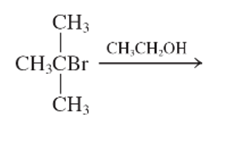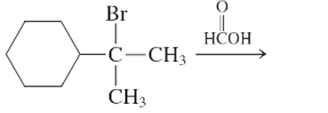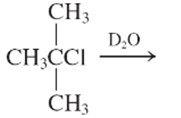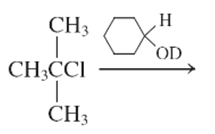
Concept explainers
(a)
Interpretation:
The E1 product for the following reaction should be written.

Concept Introduction:
A type of organic reaction in which two substituents get eliminated from a given molecule by one step mechanism or two step mechanism is known as elimination reaction. The reaction which occurs in one step is known as E2 reaction whereas the reaction which occurs in two steps is known as E1 reaction.
In E1 reaction, elimination of HX substituent takes place and produces a double bond. It is a unimolecular reaction.
(b)
Interpretation:
The E1 product for the following reaction should be written.

Concept Introduction:
A type of organic reaction in which two substituents get eliminated from a given molecule by one step mechanism or two step mechanism is known as elimination reaction. The reaction which occurs in one step is known as E2 reaction whereas the reaction which occurs in two steps is known as E1 reaction.
In E1 reaction, elimination of HX substituent takes place and produces a double bond. It is a unimolecular reaction.
(c)
Interpretation:
The E1 product for the following reaction should be written.

Concept Introduction:
A type of organic reaction in which two substituents get eliminated from a given molecule by one step mechanism or two step mechanism is known as elimination reaction. The reaction which occurs in one step is known as E2 reaction whereas the reaction which occurs in two steps is known as E1 reaction.
In E1 reaction, elimination of HX substituent takes place and produces a double bond. It is a unimolecular reaction.
(d)
Interpretation:
The E1 product for the following reaction should be written.

Concept Introduction:
A type of organic reaction in which two substituents get eliminated from a given molecule by one step mechanism or two step mechanism is known as elimination reaction. The reaction which occurs in one step is known as E2 reaction whereas the reaction which occurs in two steps is known as E1 reaction.
In E1 reaction, elimination of HX substituent takes place and produces a double bond. It is a unimolecular reaction.
(e)
Interpretation:
The E1 product for the following reaction should be written.

Concept Introduction:
A type of organic reaction in which two substituents get eliminated from a given molecule by one step mechanism or two step mechanism is known as elimination reaction. The reaction which occurs in one step is known as E2 reaction whereas the reaction which occurs in two steps is known as E1 reaction.
In E1 reaction, elimination of HX substituent takes place and produces a double bond. It is a unimolecular reaction.
(f)
Interpretation:
The E1 product for the following reaction should be written.

Concept Introduction:
A type of organic reaction in which two substituents get eliminated from a given molecule by one step mechanism or two step mechanism is known as elimination reaction. The reaction which occurs in one step is known as E2 reaction whereas the reaction which occurs in two steps is known as E1 reaction.
In E1 reaction, elimination of HX substituent takes place and produces a double bond. It is a unimolecular reaction.
Want to see the full answer?
Check out a sample textbook solution
Chapter 7 Solutions
Organic Chemistry: Structure and Function
- Make a table with the main conditions for each mechanism: E1, E2, SN1, SN2.arrow_forwardIdentify the reagents from a to e in this reaction.arrow_forwardTopic: Elimination of Alkyl Halides When 2-bromobutane is reacted with CH3O-, two alkene products, namely 2-butene and 1-butene are obtained. Give an explanation why the E2 reaction produces 2-butene as the major productarrow_forward
- SN1 reactions undergo carbocation rearrangements, but E1 reactions do not because the carbocation intermediate does not last as long during the elimination process. True O Falsearrow_forwardWhich of the products will react the fastest given an SN2 reaction ?arrow_forwardArrange the compounds below in order of increasing reactivity in a SN2 reaction. 1. (CH3)2СНCI 2. CH3CH2B1 3. CH3CH2C1 A) 1; 2; 3 В) 3;B 2; 1 C) 1; 3; 2 D) 2; 1; 3 E) 3; 1; 2arrow_forward
- The following two reactions are performed on the same starting material; one producing “product 1" and one producing "product 2" as the major products. Which of the following statements is false regarding these two reactions? Both of these reactions proceed A via a carbocation intermediate. Product 1 is a substitution В product. The leaving group in the reaction producing product 2 is H20. C Product 2 is a disubstituted alkene. Both of these reactions proceed E via a unimolecular reaction mechanism. он HCI (conc.) Product 1 (Major) он H2SO4 (conc.) Product 2 (Major)arrow_forwardTertiary alkyl halides will react by E2 under neutral conditions under acidic conditions under basic conditions will not react by E2arrow_forwardPlace the product of each reaction in the next to conditions. Снз мамна гед THE DC H3CX CH3 вк вг Natt Et₂0,0°Carrow_forwardWhich of the compounds shown below can undergo an SN2 reaction? A OTS Br 1) Compound C 2) Compounds B and D 3) Compounds A, B and D 4) Compounds A and B B C Br Br Darrow_forward5. Predict whether each reaction will occur via SN2 or E2 mechanism and draw the product. Write 'NR' if the reaction will not proceed as written. & CH3CI NaCl Acetone KOt-Bu t-BuOH KOt-Bu t-BuOH NaOEt EtOHarrow_forwardFill in the missing structure(s) for the reaction pathways shown below. Provide allstarting material(s), reagent(s), or product(s). If more than one product can be formed,draw all major products. If more than one starting material or reagent is possible, writeall starting materials and reagents.arrow_forwardarrow_back_iosSEE MORE QUESTIONSarrow_forward_ios
 Organic ChemistryChemistryISBN:9781305580350Author:William H. Brown, Brent L. Iverson, Eric Anslyn, Christopher S. FootePublisher:Cengage Learning
Organic ChemistryChemistryISBN:9781305580350Author:William H. Brown, Brent L. Iverson, Eric Anslyn, Christopher S. FootePublisher:Cengage Learning

